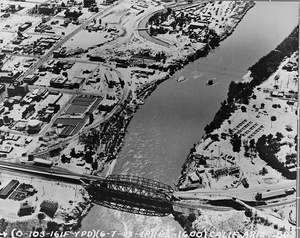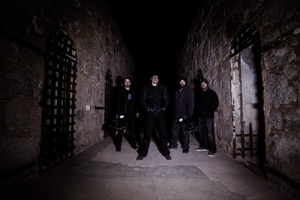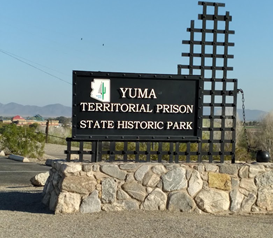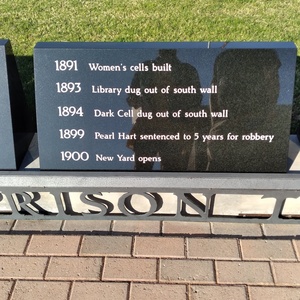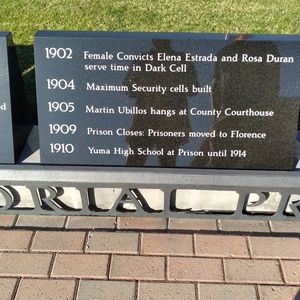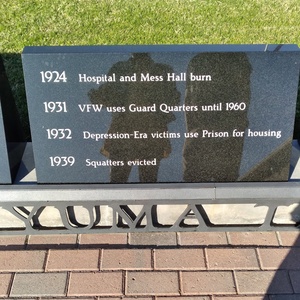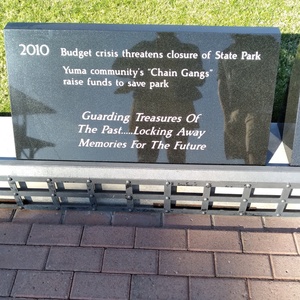"Ghost Adventures" filmed at the Yuma Territorial Prison
Resting hillside overlooking the Colorado River and just a few miles west of where the Gila River unites with the Colorado remains the ruins of Arizona’s infamous Territorial Prison. In 1849 Yuma began to experience the American Westward rush when numerous immigrants arrived by ferry going across Yuma on the way to the California gold rush. Furthermore, due to the discovery of placer gold on the Colorado River Yuma experienced a surge in population in 1858. Consequently, Yuma incorporated and became the county seat. By 1875 Territorial Governor Safford recommended the construction of a territory prison. In fact, The competition of several towns included Prescott, Florence and Phoenix to secure the prison with that the original location plan of the new prison was said to be built in Phoenix AZ but during the legislative session that took place that same year Yuma city leaders , CouncilmanJose Maria Redondo and Rep. R.B Kelly cleverly amended the bill to read “Yuma” in the place of Phoenix. The measure passed and Yuma became the site of the coveted Territorial Prison.
This desert Alcatraz constructed with thick adobe walls and resting on granite hillside with the current of the river to the East and North while miles of barren harsh desert stood South and West provided natural barriers. From there, the Yuma Territorial Prison State Park now located in Yuma, Arizona is a historical landmark that put the little town of Yuma on the Maps. The former prison opened on July 1, 1876, approved by territorial legislature in 1875 and given a budget of $25,000 for the project. That following year the prison was first opened and moved in the first 7 convicted inmates. Over the duration of 33 years of operation between 1876 to 1909, the prison contained a total of 3,069 convicts including 29 women all convicted of crimes ranging from polygamy to murder. Built on a solid rock foundation; The cells were feet by eight with high domed ceiling with poor ventilation. Inside the cells were two metal tiers of bunks three bunks to each tier therefore holding six inmates to each cell with no wash bowl or furniture and no toilet, except for a bucket that was emptied once a day. If anyone knows anything about Yuma, they will tell you it is hot, hot, hot. During the months of May through September Yuma heat came with for its scorching high temperatures that made this place an inferno the temperatures could get as high as 120 degrees. As a result, inmates labeled this old west prison as a literal “hell hole”. It is said that The Yuma Territorial Prison was one of the toughest facilities at this time. For inmates who broke prison regulations they were sentenced to time in the “Snake Den” prisoners who disobeyed had to sit in the pitch-dark stone room shackled with no bed and no outside contact except to receive bread and water once a day. This was a well recorded punishment, records from past inmates showed just how brutal this prison could be. The rough nature of this prison combined with the horrid environment made for an utterly grotesque experience.
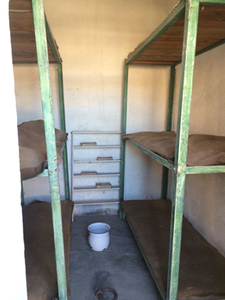
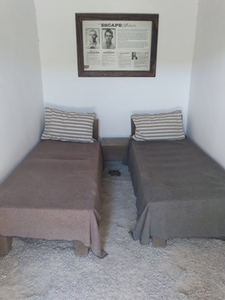 Original iron bunk beds and layout of the cells
Original iron bunk beds and layout of the cells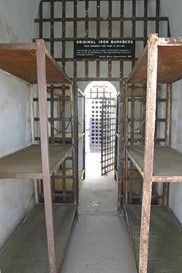 typically there was 6 inmates to a cell
typically there was 6 inmates to a cell
Despite all that, historical records indicate the prison was humanely managed prisoners had free time in which they read and crafted many items. Prisoners also had regular medical attention and access to a hospital. Schooling was also available, prisoners were given the opportunity to learn to read and write, they were also taught how to speak Spanish and German. They also had access to medical care a fully functioning library. Inmates on good behavior were given the opportunity to be entertained by musical bands, prisoners were also given the chance to join the prison band as well. Many of the stories written by writers about the prison have surely been exaggerated beyond truth, mostly to make it appear like horrendous but among historians who will say that the prison was a model institution and one of the better ones in the West for its time. The prison was often referred to as a country club due to the amenities this facility possessed. The prison had the largest library in the territory during its time while also having one of the first complete sanitation systems in a prison. Not to mention this prison also had electricity and forced ventilation. This prison was managed and operated by a very progressive staff as well.
The prison was served by 15 male superintendents throughout its course of operation. Superintendents were in charge of prisoners aiding in monitoring their behavior while also managing the function of the prison. These Superintendents were appointed by the Territorial Governor and given a base salary of 250$ a month, two of the most notable Superintendents were F.S. Ingalls (June 1883-July 1886, October 1889-September 1891) and Thomas Gates (July 1886-October 1887, July 1893-July 1896). F.S. Ingalls ordered for an engine room to be built shifting the prison away from coal and towards electricity. This was one of the first prisons in the west to make use of this new technology. Ingalls' wife also aided in improving opportunities for prisoners and constructing a library within one of the buildings. These changes made by Ingalls allowed for the Yuma Territorial Prison to be viewed as a staple example of a modern prison. Thomas Gates on the other hand made an impact by showing leniency during his reign but also being a stern Superintendent. Gates was noted as a fair man who wasn't unreasonable. These two men left lasting footprints on this prison, however, not every superintendent was fit to the bill. John Behan (October 1887- October 1889) was regarded as a questionable superintendent, Behan served as a sheriff in Cochise County before being appointed. Behan suffered from heavy criticism from both new outlets and political figures due to his poor leadership. Different to Behan M.M. McInernay (September 1891-April 1893) faced criticism for alleged poor management. McInernay was indicted in an embezzlement case which was apparently used to attack his reputation. McInernay aside from his controversy was noted to have improved facility bathrooms and also guard towers. One of the last notable Superintendents was William K. Meade (April 1893-May 1893) who only served one month, the shortest term served by any Superintendent.
Among those 3,069 inmates ranging in age from fourteen to eighty-eight, men, women all by various ethnicities that were housed by the Yuma Territorial Prison were some of the roughest and toughest characters the West has ever known. Including Buckskin Frank Leslie, scout, marksman and all-around tombstone character, Pearl Hart; female stagecoach robber, who was made famous by embellished newspaper articles and following her released tried her hand in acting from there no one knows for sure what happened after that. Also included were Mexican revolutionaries who were part of the Partido Liberal Mexicano, otherwise known as Magonistas all included members Ricardo Flores Magon, Librado Rivera, and Antonio I. Villarreal. More can be said about the vast and notable prisoners held within this facility, many of the prisoners held vast criminal backgrounds and were weathered outlaws. Buckskin Frank Leslie was touted to be one of the fastest gunslingers of his era, notably killing Billy Clairborne of the Clanton Gang. Leslie was also responsible for the murder of his wife whom he attacked in a drunken rage. Aside from Leslie, Richard Flores Magon also sticks out among his fellow compatriots. Richard founded the Partido Liberal Mexicano to fight against dictator Porfirio Diaz. Richard was eventually jailed in Yuma due to violating the Neutrality Act, this led to him getting transferred into the Leavenworth Penitentiary. Richard passed away due to what has been described as questionable circumstances. The prisoner's history goes on forever, holding some of the most infamous names of the prison's era. This jail truly was the desert Alcatraz.
By 1909 the prison closed down due to overcrowding and no room for expansion of the prison and inmates were transferred to a newer facility in Florence Arizona. Even though the institution was closed, its history was far from over. After the prison officially closed in 1909 a fire took The Yuma High School, so they used the prison as a location for classes for a short time until proper facilities were built for the students. Yuma Union High School occupied the buildings from 1910 to 1914. When the school's football team played against Phoenix and won, the Phoenix team called the Yuma team "criminals “as an insult from which Yuma High eventually adopted the nickname with pride calling themselves the Yuma High Criminals to this day. After that, the prison building was used as a shelter for the homeless during the Great Depression and even a movie location for old western films like Three-Ten to Yuma both the original and the remake(2007), Riot and many more. Later floods, theft, railroad expansion and the building of the Ocean to Ocean Highway destroyed sections of the prison.
The Yuma Territorial Prison did indeed hold some of the west's finest criminals but now many paranormal investigators scour to visit this historic location. Many ghost hunters within the state of Arizona consider the prison a hot spot for other worldly activity. The prison saw its fair amount of deaths throughout its operation which many believe is the reason why it attracts ghosts. Visitors have claimed they've heard screams, voices, and other unexplained noises while paying this landmark a visit. These claims were supported by prison history which indicated there could be spirits left behind on the prison's premises. A prison Superintendent was most famously killed during a large riot which resulted in a few prisoner deaths during its chaos. According to investigators the Dark Room and main Cell Block have the highest amount of ghost presence. During public visitation hours guests are allowed to stand inside the Dark Room during tours. Guests have often claimed they instantly felt the sense that they were being watched. This claim can be supported by the account of an Arizona Highway writer who attempted to stay inside the Dark Room for 48 hours, the challenge failed just short of 2 days due to the writer feeling uneasy alone within the cell. Staff workers also note that spirits frequently patrol the gift shop allegedly rearranging the change inside the cash register. Many third party businesses will take individuals on professional ghost tours in the facility, this is a huge hotspot for all paranormal junkies. The Yuma Territorial prison was famously included on "Ghost Adventures," where paranormal investigators record an episode examining the premises for any possible hints of spirit activity. The crew used high quality equipment and actually captured a scream during the show. The team brought in eyewitnesses and based their investigation on information from the locals. The group of investigators were frequently teased by weird sounds and strange voices leading them to believe that there was indeed a strange energy inside the prison. The cameras caught evidence of a “ghostly band,” attempting to communicate with them along with a long past prisoner. This episode was aired in 2016 and received high marks on IMDB. This fueled the legitimacy of claims made about the strange occurrences that would happen behind prison walls.
Then by 1939 the Yuma townspeople took notice on the importance and historic significance this place offered. So, the community worked together thus by 1941 the museum was put up and operated for the next twenty years. From there the Yuma Territorial State Prison became Arizona’s third state park. Today the only original adobe structure that remains in the “Sally Port entrance”. Along with that the dark cell, the regular cells and the main guard tower has since been reconstructed but still stands in their original place. The Territorial Prison at Yuma, Arizona, is a fascinating side trip to take when in the Yuma area. The park is labeled as Yuma’s number one tourist site bringing in people from around the world to learn the history of an important piece of Yuma History. Although the park is a smaller facility it still offers tons of entertainment and history on the Yuma territorial Prison this includes interactive exhibits, photographs, personal narratives of prisoners and prison staff it also includes restrooms and a gift shop full of great prison t shirts, keychains, books about the prison. Locals view this park with a sense of nostalgia, this now museum has provided the community with years of activity. This park is a staple landmark to the town signifying an important piece of history for all residents, this is a must visit location for all Yuma residents. So, for thirty-three years the thick adobe walls of the Yuma Territorial Prison restrained those who broke the law but now it welcomes those who seek to walk in their footsteps.
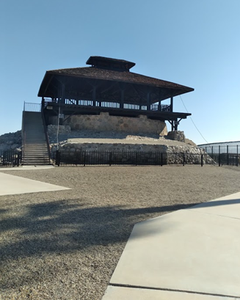 Main Guard Tower was also used as a water reservoir.
Main Guard Tower was also used as a water reservoir. 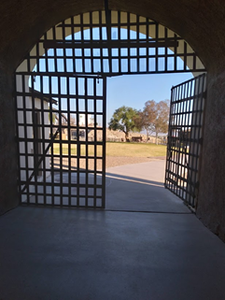 Sally Port that still stands today as the only entrance and exit through the prison.
Sally Port that still stands today as the only entrance and exit through the prison.
Timeline of Yuma Territorial Prison's historical events.
Park and Facility Hours
Thursday-Monday
9:00 a.m. - 5:00 p.m.
Closed Tues - Wed
Park Entrance Fee
Adult (14+): $8.00
Youth (7–13): $4.00
Child (0–6): FREE
Donate/Invest
The Yuma Crossing National Heritage Area appreciates your support which allows us to preserve the Yuma Territorial Prison.
The Yuma Crossing National Heritage Area now accepts PayPal Donations for easier convenience.
To Donate with a check, send to:
Yuma Crossing National Heritage Area
180 W. 1st Street, Suite E
Yuma, AZ 85364
References:
Desert Alcatraz: The Arizona Territorial Prison, S.J. Friday, 1985
Park History, Yuma Territorial Prison State Historic Park, February 17, 2021, https://www.azstateparks.com/yuma-territorial/about-the-prison/park-histor
The history of Yuma and the Territorial Prison, Woznick, 1995
The Yuma Territorial Prison State Park
Yuma Territorial Prison, February 20, 2021, https://en.wikipedia.org/wiki/Yuma_Territorial_Prison
Yuma Territorial Prison, February 19, 2021, https://www.desertusa.com/yuma/du_yumatp.html?
Yuma Territorial Prison, September 1, 2022 https://www.yumaheritage.com/yuma-territorial-prison.html
Yuma Territorial Prison State Historic Park, September 1, 2022 https://www.visitarizona.com/places/parks-monuments/yuma-territorial-prison-state-historic-park/

